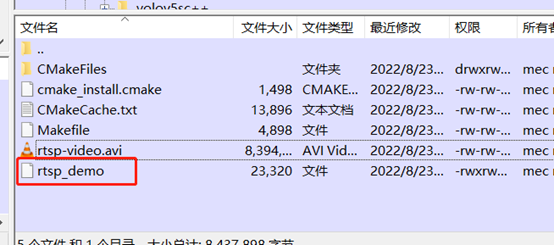基于opencv的RTSP(rtsp)流读取和保存(C++可cmake编译-附带py方法)
因其工作需要使用C++读取rtsp流,本文将针对linux下c++版读取视频流保存视频,凌乱且各种错误。现将将其成功执行的流程和代码记录,顺带也写了一份python读取rtsp方法,供自己使用及有需之人参考。本文分三部分,第一部分呈现CMakeLists.txt与rtsp_video源码;第二部分插图给出使用方法;第三部分顺带给出python方法的源码。
一.CMakeLists.txt与rtsp_video源码
CMakeLists.txt
cmake_minimum_required(VERSION 2.6)
project(rtsp)
find_package( OpenCV REQUIRED )
include_directories( ${OpenCV_INCLUDE_DIRS} )
add_executable(rtsp_demo rtsp_video.cpp)
target_link_libraries( rtsp_demo ${OpenCV_LIBS} )
rtsp_video.cpp
#include <iostream>
#include <opencv2/core/core.hpp>
#include<opencv2/highgui/highgui.hpp>
#include <opencv2/opencv.hpp>
using namespace cv;
using namespace std;
int main() {
std::string rtspPath = "rtsp://admin:Vrc123456@192.168.2.226:554";
VideoCapture cap;
cap.open(rtspPath);
if (!cap.isOpened())
{
cout << "cannot open video!" << endl;
return 0;
}
VideoWriter writer = VideoWriter("./rtsp-video.avi",//path and filename
(int)cap.get(CAP_PROP_FOURCC),
(int)cap.get(CAP_PROP_FPS),
Size((int)cap.get(CAP_PROP_FRAME_WIDTH),
(int)cap.get(CAP_PROP_FRAME_HEIGHT)),
true//colorfull pic
);
if (!writer.isOpened()) {
cout << "create vedio failed!" << endl;
return 0;
}
while (1)
{
cv::Mat frame;
cap >> frame;
if (frame.empty())
{
cout << "frame is empty!" << endl;
break;
}
cv::Mat img = frame;
//cv::imshow("frame", img);
writer<<img;
//waitKey(1);
}
return 0;
}
注:opencv安装参考网络方法
二.使用方法
步骤1:
打开rtsp_video.cpp文件修改流接口:
std::string rtspPath = "rtsp://admin:Vrc123456@192.168.2.226:554";

步骤2:
将整个文件夹传入需编译服务器,文件内容包括红框内容:

以下类似编译过程
步骤3:执行
cmake .
make
可出现rtsp_demo,以下红框

无需录视频,执行 ctrl+c 按键
保存视频为rtsp-video.avi
三.python方法的源码
import cv2 cap = cv2.VideoCapture('rtsp://admin:Vrc123456@192.168.2.226:554') fourcc = cv2.VideoWriter_fourcc(*'XVID') size = (int(cap.get(cv2.CAP_PROP_FRAME_WIDTH)), int(cap.get(cv2.CAP_PROP_FRAME_HEIGHT))) out = cv2.VideoWriter('./rtsp_video.avi', fourcc,10.0, size) while True: ret, frame = cap.read() out.write(frame) cv2.imshow('frame', frame) cv2.waitKey(1) cap.release() out.release() cv2.destroyAllWindows()





【推荐】国内首个AI IDE,深度理解中文开发场景,立即下载体验Trae
【推荐】编程新体验,更懂你的AI,立即体验豆包MarsCode编程助手
【推荐】抖音旗下AI助手豆包,你的智能百科全书,全免费不限次数
【推荐】轻量又高性能的 SSH 工具 IShell:AI 加持,快人一步
· 震惊!C++程序真的从main开始吗?99%的程序员都答错了
· 别再用vector<bool>了!Google高级工程师:这可能是STL最大的设计失误
· 单元测试从入门到精通
· 【硬核科普】Trae如何「偷看」你的代码?零基础破解AI编程运行原理
· 上周热点回顾(3.3-3.9)